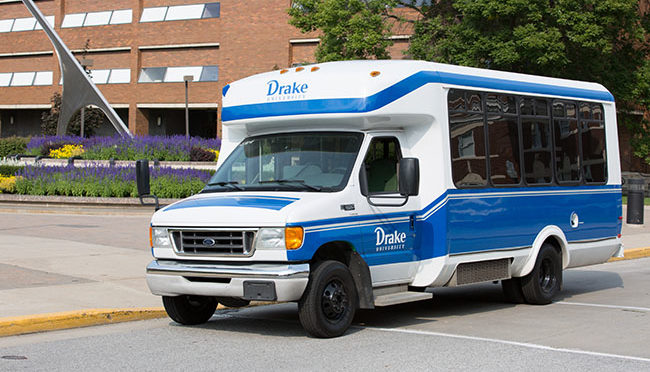Des Moines Police Patrol
In response to recent incidents in the Drake community, Drake has contracted for a uniformed Des Moines Police Department officer to be dedicated to the Drake campus in the evenings. The officer will patrol primarily from 25th Street to 34th Street on both Forest and University. The officer will primarily be here from 7 p.m. to 6 a.m., seven days a week, for the next few weeks to help serve as a visible deterrent and expedite response time.
Safe Ride
As many of you know, Drake recently introduced the new Safe-Ride program, a Drake-owned bus that provides late-night transportation service in the immediate Drake neighborhood. The service has been very successful and demand in the evenings has exceeded capacity on some weekend nights. In order to increase visibility and provide additional capacity, a second bus will operate Thursday, Friday, and Saturday evenings. It is our hope that students will choose to use the Safe-Ride service for travel around the Drake neighborhood at night. The location of the Safe-Ride bus can be found by visiting www.drake.edu/bus. The bus runs 8 p.m. to 1 a.m. Sunday–Wednesday and 8 p.m. to 2:30 a.m. Thursday–Saturday. The two buses will travel opposite circuits around campus to maximize response time.
Drake Guardian App
Drake Public Safety would also like to remind students, faculty, and staff to download the “Drake Guardian” App. This app is available as a free download and enhances safety on campus through real-time, interactive features that create a virtual safety network of friends, family, and Drake’s Department of Public Safety. Features include a panic button that connects you immediately to Drake Public Safety and anonymous texting for crime tip reporting. The app also allows your network to monitor your location when you set a safety timer. For more information, visit the Drake Public Safety site. The app is also available in the App Store and through the Android App by searching for Rave Guardian. Once the Rave Guardian is downloaded and you enter your drake.edu email, the app becomes the “Drake Guardian.”
Timely warnings vs. Bulldog Alerts
The Director of Public Safety or a designee will develop Timely Warning Notices for the University community to notify campus about serious crimes against people that have already occurred on or near campus, where it is determined that the incident may pose an ongoing threat to members of the University community. Timely Warning Notices may be distributed for other crimes as determined necessary by the Director or his or her designee in his or her absence.
Bulldog Alerts are issued for an emergency or dangerous situation involving an immediate threat to the health or safety of students or employees that is currently occurring on or may imminently affect the campus.
As always, if you see something, say something. If you see something you feel is out of ordinary, no matter how trivial it may seem, contact Drake Public Safety at 811 (emergency) or 515-271-2222 (non-emergency). DPS has 21 sets of eyes, but with the campus community, we have more than 5,000.
—Submitted by Scott Law, Director, Drake Public Safety

